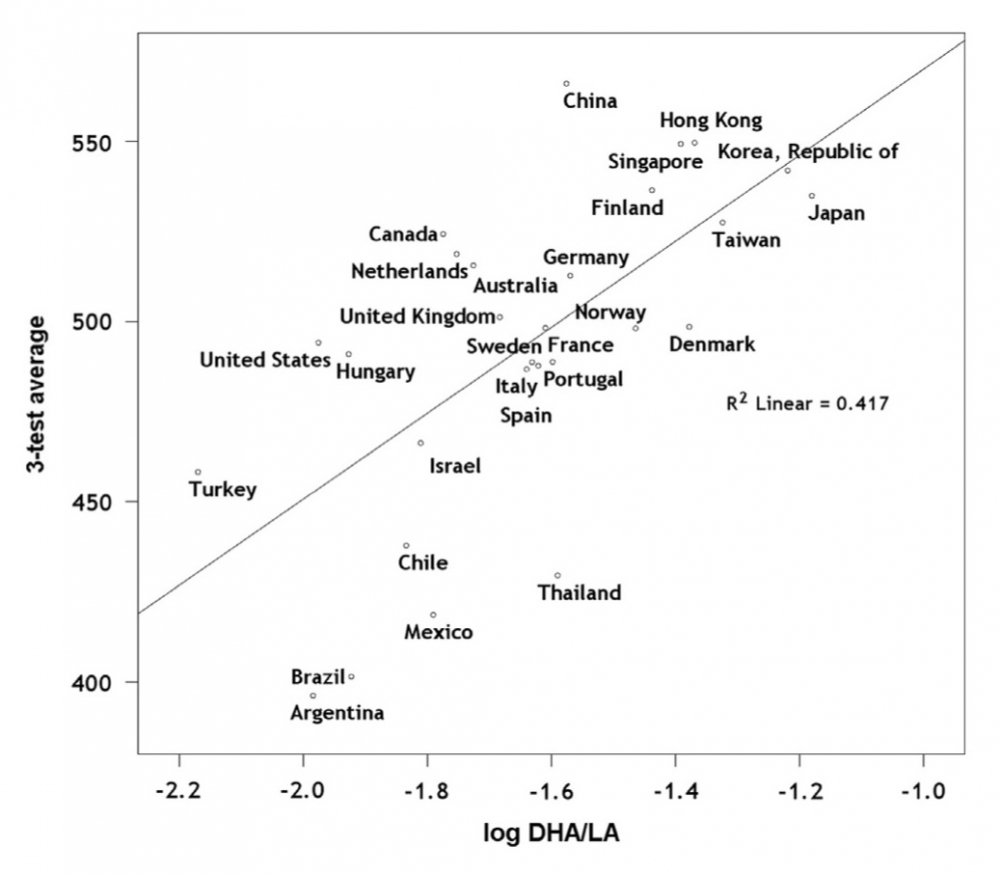
Hold the Mayo


You are what you eat, the saying goes, and now a study conducted by researchers at UC Santa Barbara and the University of Pittsburgh suggests that the oft-repeated adage applies not just to physical health but to brain power as well.
In a paper published in the early online edition of the journal Prostaglandins, Leukotrienes and Essential Fatty Acids, the researchers compared the fatty acid profiles of breast milk from women in over two dozen countries with how well children from those same countries performed on academic tests.
Their findings show that the amount of omega-3 docosahexaenoic acid (DHA) in a mother’s milk — fats found primarily in certain fish, nuts and seeds — is the strongest predictor of test performance. It outweighs national income and the number of dollars spent per pupil in schools.
DHA alone accounted for about 20 percent of the differences in test scores among countries, the researchers found.
On the other hand, the amount of omega-6 fat in mother’s milk — fats that come from vegetable oils such as corn and soybean — predict lower test scores. When the amount of DHA and linoleic acid (LA) — the most common omega-6 fat — were considered together, they explained nearly half of the differences in test scores. In countries where mother’s diets contain more omega-6, the beneficial effects of DHA seem to be reduced.
“Human intelligence has a physical basis in the huge size of our brains — some seven times larger than would be expected for a mammal with our body size,” said Steven Gaulin, UCSB professor of anthropology and co-author of the paper. “Since there is never a free lunch, those big brains need lots of extra building materials — most importantly, they need omega-3 fatty acids, especially DHA. Omega-6 fats, however, undermine the effects of DHA and seem to be bad for brains.”
Both kinds of omega fat must be obtained through diet. But because diets vary from place to place, for their study Gaulin and his co-author, William D. Lassek, M.D., a professor at the University of Pittsburgh’s Graduate School of Public Health and a retired assistant surgeon general, estimated the DHA and LA content — the good fat and the bad fat — in diets in 50 countries by examining published studies of the fatty acid profiles of women’s breast milk.
The profiles are a useful measure for two reasons, according to Gaulin. First, because various kinds of fats interfere with one another in the body, breast milk DHA shows how much of this brain-essential fat survives competition with omega-6. Second, children receive their brain-building fats from their mothers. Breast milk profiles indicate the amount of DHA children in each region receive in the womb, through breastfeeding, and from the local diet available to their mothers and to them after they are weaned.
The academic test results came from the Programme for International Student Assessment (PISA), which administers standardized tests in 58 nations. Gaulin and Lassek averaged the three PISA tests — math, science and reading ability — as their measure of cognitive performance. There were 28 countries for which the researchers found information about both breast milk and test scores.
“Looking at those 28 countries, the DHA content of breast milk was the single best predictor of math test performance,” Gaulin said. The second best indicator was the amount of omega-6, and its effect is opposite. “Considering the benefits of omega-3 and the detriment of omega-6, we can get pretty darn close to explaining half the difference in scores between countries,” he added. When DHA and LA are considered together, he added, they are twice as effective at predicting test scores as either is alone, Gaulin said.
Gaulin and Lassek considered two economic factors as well: per capita gross domestic product (a measure of average wealth in each nation) and per student expenditures on education. “Each of these factors helps explain some of the differences between nations in test scores, but the fatty acid profile of the average mother’s milk in a given country is a better predictor of the average cognitive performance in that country than is either of the conventional socioeconomic measures people use,” said Gaulin.
From their analysis, the researchers conclude that both economic wellbeing and diet make a difference in cognitive test performance, and children are best off when they have both factors in their favor. “But if you had to choose one, you should choose the better diet rather than the better economy,” Gaulin said.
The current research follows a study published in 2008 that showed that the children of women who had larger amounts of gluteofemoral fat “depots” performed better on academic tests than those of mothers with less. “At that time we weren’t trying to identify the dietary cause,” explained Gaulin. “We found that this depot that has been evolutionarily elaborated in women is important to building a good brain. We were content at that time to show that as a way of understanding why the female body is as evolutionarily distinctive as it is.”
Now the researchers are looking at diet as the key to brain-building fat, since mothers need to acquire these fats in the first place.
Their results are particularly interesting in 21st-century North America, Gaulin noted, because our current agribusiness-based diets provide very low levels of DHA — among the lowest in the world. Thanks to two heavily government-subsidized crops — corn and soybeans — the average U.S. diet is heavy in the bad omega-6 fatty acids and far too light on the good omega-3s, Gaulin said.
“Back in the 1960s, in the middle of the cardiovascular disease epidemic, people got the idea that saturated fats were bad and polyunsaturated fats were good,” he explained. “That’s one reason margarine became so popular. But the polyunsaturated fats that were increased were the ones with omega-6, not omega-3. So our message is that not only is it advisable to increase omega 3 intake, it’s highly advisable to decrease omega-6 — the very fats that in the 1960s and ’70s we were told we should be eating more of.”
Gaulin added that mayonnaise is, in general, the most omega-6-laden food in the average person’s refrigerator. “If you have too much of one — omega-6 — and too little of the other — omega 3 — you’re going to end up paying a price cognitively,” he said.
The issue is a huge concern for women, Gaulin noted, because “that’s where kids’ brains come from. But it’s important for men as well because they have to take care of the brains their moms gave them.
“Just like a racecar burns up some of its motor oil with every lap, your brain burns up omega-3 and you need to replenish it every day,” he said.



